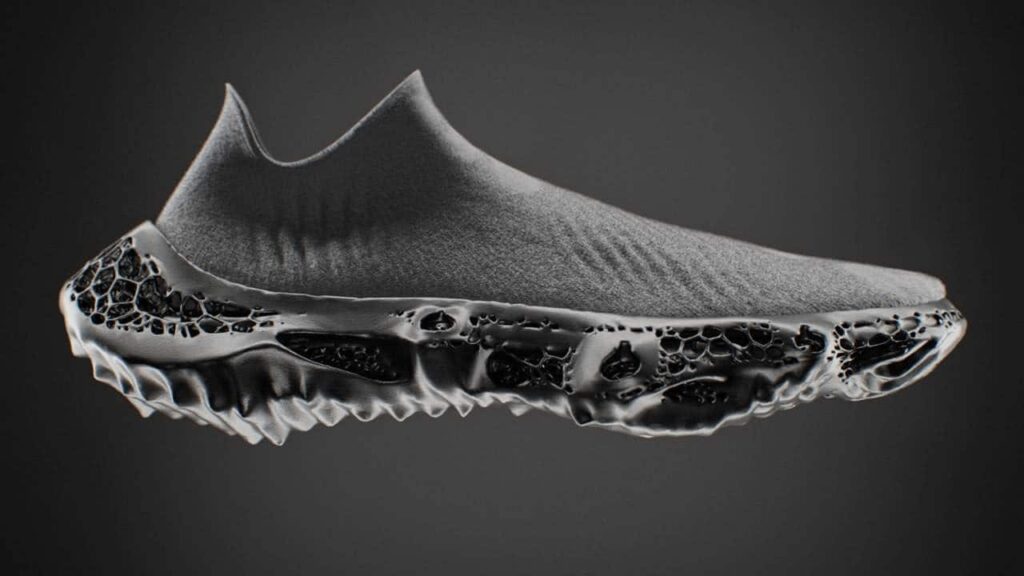At textile trade fair ITMA in Milan, Decathlon, Lonati Group and HP showcased the latest in 3D printed shoes. Decathlon’s latest footwear concept features a midsole and outsole produced using HP’s Multi Jet Fusion (MJF) technology and Lonati’s knitted uppers.
Like most sportswear manufacturers, Decathlon’s mass production occurs in Asia, where multiple parts are assembled. The $11-billion French conglomerate attempts to implement the necessary procedures to combat forced labor and workplace hazards across a sprawling supply chain that spans 44 countries. With automation, Decathlon and similar companies aim to ensure tighter, local control over its manufacturing.
Demonstrating the possibilities, Decathlon partnered with HP and Lonati to produce its latest sports shoe concept. The sole is 3D printed from BASF Ultrasint TPU01 using an HP Jet Fusion 5200 system. The upper is then weaved using a Lonati XT-Machine. Because the shoes are not glued together, they can be recycled more easily, while the use of digital manufacturing technologies not only enables customer personalization but also less reliance on physical stock.

A Decathlon shoe made with HP’s MJF 3D printing technology and a knitted upper made using technology from Lonati Group. Image courtesy of Sportstextiles.com.
Italy’s Lonati has been in the business of making equipment for sock and hosiery weaving for 70 years but began ramping up its efforts in automated upper manufacturing circa 2018. Its GOSHOES line for weaving shoe uppers has resulted in R&D dedicated to developing a complete shoe manufacturing line.
A large driver of the adoption of 3D printing in footwear is the same for manufacturing at large: the need for automation in the face of global economic and social changes. In particular, the drop in accessible fossil fuels has resulted in increased energy prices, which feeds the need to bring manufacturing closer to the point of use. All of this has been exacerbating the overall supply chain crises related to macro events like COVID-19 and the war in Ukraine.
While 3D printed midsoles are beginning to reach the point of mass production, uppers have been traditionally more difficult to tackle. A number of fully 3D printed shoes have attempted to tackle this problem by using foam-like materials and pushing the couture potential of the single-print aesthetic. This could certainly attract younger and hipper consumers, but as that catches on, a more practical approach to uppers would need to be achieved for 3D printed shoes to be economical and marketable.
The answer may be in the form of industrial knitting combined with 3D printing, as demonstrated by Decathlon, Lonati Group and HP. It is likely that, in combination with knitting technologies, that the sector for additively manufacturing foot wear will achieve $4.2 billion in revenues by 2025, according to the “3D-Printed Footwear 2020-2030, an Analysis of the Market Potential of 3D Printing in the Footwear Industry” report from SmarTech Analysis.
Subscribe to Our Email Newsletter
Stay up-to-date on all the latest news from the 3D printing industry and receive information and offers from third party vendors.
You May Also Like
Formnext Day Three: Rock & Zoll
The biggest news on day three was, of course, the reactions to the band at the exhibitor’s party. The soirée was well attended, with the crowd rocking on until early...
Welcome to the Desktop 3D Printing Revolution: Astronomics
In 2014, I wrote that FDM desktop 3D printers would not be suited for production. By 2018, however, we were making parts for highly regulated industries using Ultimaker desktop machines....
3DPOD 227: 3D Printing Optimization with Harshil Goel, CEO of Dyndrite
Harshil Goel founded Dyndrite as a kernel designed for 3D printing. While this core technology remains available for OEMs and software firms, the company now also offers a tool that...
3DPOD 226: Simulation and Optimization with Pan Michaleris, PanOptimization
Pan Michaleris has been working in finite element analysis (FEA) and related fields for decades. As a professor, he contributed significantly to the discipline and later developed CUBES, which was...



































